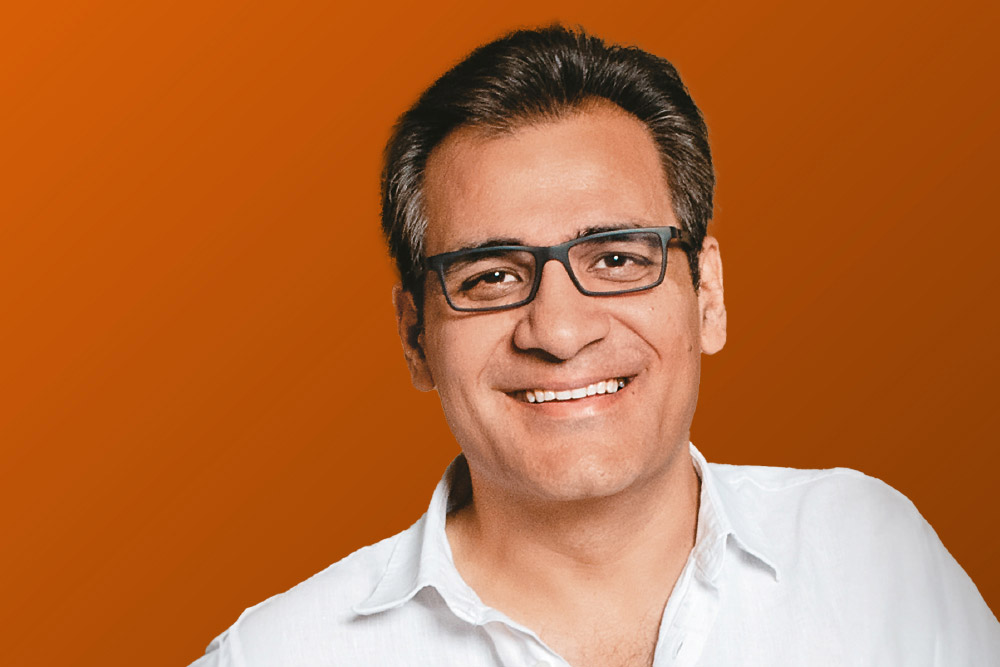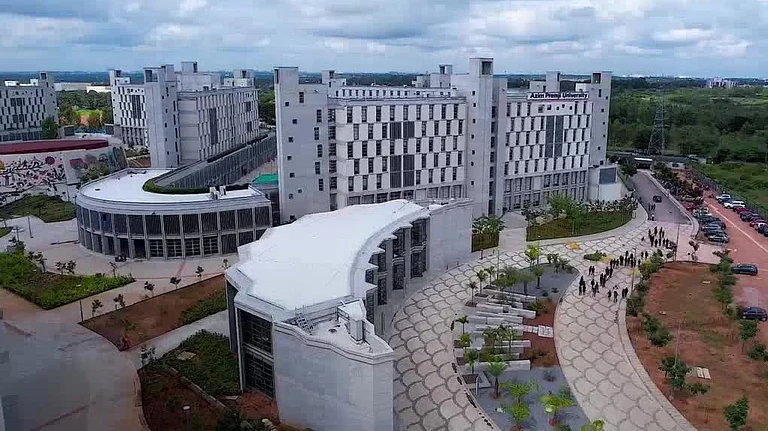He was repeatedly stopped by burly security guards near the prime minister’s official residence on Delhi’s Lok Kalyan Marg (at the time called Race Course Road) and grilled about why he was in the neighbourhood. His frequent visits to the Bharat Petroleum station nearby had raised suspicion. It took a lot of reasoning and a bit of charm for him to convince the guards posted there that he was getting in on the ground floor of the technology that would transform how consumers bought and businesses sold things in future.
This was how Anil Bhatt started his career, after finishing a computer science and engineering course from the BSF Institute of Technology in Bengaluru. Today, Bhatt is the global chief information officer (CIO) of Elevance Health—a Fortune 500 company and one of America’s biggest health insurance providers. Bhatt has been at the forefront of Elevance Health’s digital-enabling of healthcare.
Back in the 1990s, when Bhatt had frequent run-ins with security personnel guarding the lane that leads to the PM’s home, he was installing the code for a point-of-sale (PoS) system at the store in the petrol pump, the first-of-its-kind in New Delhi, a system that helped turn consumers into datasets for companies to mine.
“I would instal the software code on the system from a floppy disk and later, the salespeople would tell me about the issues they faced. I would then rework the program to fix these problems; this went on for several days,” he recalls.
Looking back, Bhatt says the store visits are among the highlights of his three-decade-long career. It shaped his perspective on how to approach technology as an enabler and build solutions based on customer feedback instead of working within a tech bubble.
Starting Small
Kashmir-born Bhatt’s father worked in the army, so his family moved around a lot before they finally settled in Delhi. Growing up, he spent the better part of his day playing outdoors and was more inclined towards sports and even captained his school’s football team. Early exposure to team sports showed him why teamwork and strategy are critical if one wants to achieve a common goal.
Bhatt grew up in a small one-room apartment where the entire family slept in the living room. Those were chaotic days, surrounded by relatives, where he got what he needed, but had to work hard to get what he desired. Returning to Delhi after his graduation, Bhatt decided to do coding and advanced software export technology from Aptech, an information technology training institute.
“I was enamoured by the assembly-level language programming 8086. I loved how a small program built within a relay could be used by entities like the railways to shift tracks and control the lives of thousands of people,” he says. “Moreover, I figured that getting into software would open opportunities for me to work with multinational companies and travel the world.”
His coding journey began when he joined a five-member start-up, Connexions Technologies, where he built the first PoS for Bharat Petroleum. His other big project was creating a three-dimensional floor plan for the first Oracle OpenWorld—a global conference—in India. Visitors to the event could select the sessions they wanted to attend on a digital screen and be guided to them. “CGI [computer-generated imagery] and graphics were not big back then and given the technology, or lack of it, it was cutting-edge work,” he says.
In 1998, he moved to the US to join consumer goods major Procter & Gamble (P&G). One of the projects he worked on was developing a virtual try-on technology for its beauty-care department. It allowed users to see how a particular lipstick would look on them before they bought it. While similar applications are run-of-the-mill today, in the early 2000s it was a novelty. Bhatt spent days trying to create a tool, working with P&G’s sales teams, to understand how it could cater to their customer expectations.
Moving to the US at the cusp of the century was a milestone many a young Indian aspired to, but accompanying it was the fear of culture shock. The allure of the opportunity overshadowed any potential negatives initially for Bhatt and the daily demands of work kept him focused. However, with time, he began to recognise the disparities between the US and his native country.
“It became evident that we were navigating through a different cultural landscape, one that required [us] to be aware and [have] a willingness to adapt. Despite the initial challenges, I realised the importance of embracing this new culture and extracting the best from it,” he says.
In 2004, he joined IAC, a New York-headquartered conglomerate, to help its multi-channel retail brand HSN, which wanted to augment its consumer-focused approach and enable people to use technology in their day-to-day life.
He developed HSN Shop’s ecommerce platforms and mobile applications that offered consumers a round-the-clock, industry-first live-video three-screen experience, helping browse through the network’s 35,000-plus products. “I do not look at technology from a binary perspective, but instead believe in a human-centred design keeping in mind how consumers are going to use it,” Bhatt says.
Elevated by Elevance
It was in 2008 when Bhatt got the opportunity to lead the development team for integration architecture and services at Elevance Health (formerly Anthem Inc.). This was the big break he was looking for. “I joined Elevance as a senior engineer with a small team. Our core mandate was to keep the systems stable and identify new capabilities,” he recalls.
However, Bhatt soon realised that Elevance was not just a health insurance provider; it was a customer-focused entity where users relied on it for their daily healthcare needs and to ensure their prescriptions were delivered on time. They also wanted to engage with it to get their insurance queries answered, which meant that they needed a user-friendly digital platform.
He rose up the ranks. In 2020, he became the company’s global CIO and was tasked with developing tech strategies that would offer customer-centric healthcare solutions. He was also put in charge of leveraging artificial intelligence (AI) and data insights to enhance operational efficiency, improve care access and elevate digital experiences while managing enterprise-wide technology strategy and execution, and overseeing a global workforce of over 10,000 employees.
This task was made onerous because it was also the year when Covid-19 hit. With healthcare emerging as a focal point for most economies, Bhatt had to floor the accelerator to provide data-driven insights to various stakeholders. He and his team worked tirelessly to enhance customer access to better healthcare services and take greater control of their health management with technological advancements like Sydney Health.

When in Doubt, Dive into Data
Through this rumble and tumble in the tech rollercoaster ride, Bhatt has attempted to leave his stamp on all processes “People on the ground should feel that you are involved and are not just telling them what needs to be done. I have an open-door policy and encourage everyone to ask questions,” he says.
This culture of questioning is a two-way street and extends to the company’s board. Bhatt recalls that his proposal to introduce Sydney as an in-house health app was met with scepticism. This is where he fell back on his penchant for backing his ideas with data.
“Data never lies and is the best tool to kill preconceptions,” he says. So, he used usage metrics, user engagement and retention to show the board how Sydney could become the cornerstone of the company’s digital health strategy. Now, Elevance leans heavily on Sydney to offer access to benefits, tools and resources to over 117 million users.
Today, Bhatt plays a pivotal role in Elevance Health’s expansion and partnerships. He champions diversity and inclusion, spearheading initiatives for women in information technology, neurodivergence inclusion and youth in tech. He has been part of the top CIO roll of honour several times.
As CIOs get a bigger say in boardrooms, Bhatt believes that technocrats should leverage this opportunity judiciously. “There are a lot of expectations from CIOs and CTOs [chief technology officers] on how they can transform things. It is best to take a few bold bets where you can achieve historic results rather than doing multiple things. Your business might not be able to keep up with the complexities of change management if you propose too many things,” he says.
Bhatt is currently focused on how Elevance Health can change its internal processes by enabling technologies like generative AI. He is also working with co-pilots from various companies to change how their engineers can code faster using large language models.
For young graduates, he has a single piece of advice—go where your passion lies, but do not presume that you truly know it is your passion. Be flexible to shift gears when needed. However, once you find your calling, pursue it zealously. This is the same advice he gives to his young son and daughter. Having seen how his career has unfolded, he recommends that rather than dreaming up a 10-year roadmap, they should have shorter milestones. He also urges that they always maintain a work-life balance to avoid burn out.
Reflecting on his journey, he has realised that he often sacrificed personal time in pursuit of professional validation. The absence of familial support compounded the challenge, leading to moments of loneliness and isolation. In such instances, his wife and he leaned on each other for solace and strength.
Over time, Bhatt considers the US his karmbhoomi (place of work) while still cherishing India as his janmabhoomi (place of birth). “As life settled into a rhythm, I found myself anchored here. Yet, as time progresses, I feel a pull to return to my roots and to contribute to my community. This sense of longing shapes my future aspirations,” he says.











